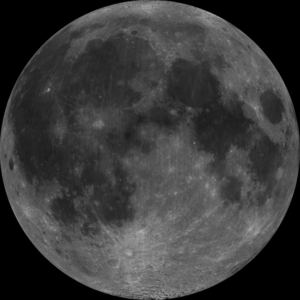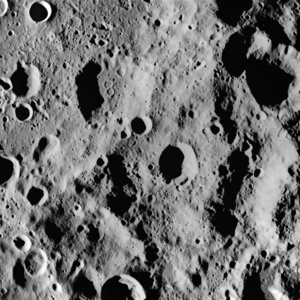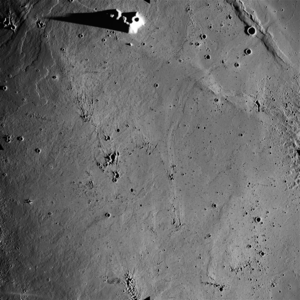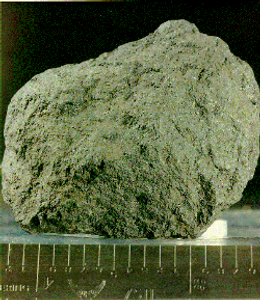
| Project Home | About the Scans | Browse Gallery | Image Map | Support Data | Resources | Ephemeris |
Featured Image - 07/22/2008
Lunar Highs and Lows
When we look at the full Moon in the evening sky, two regions of light and dark material are immediately apparent. As children, our imaginations were able to take this interplay of light and dark and construct images of the 'Man in the Moon' or 'Bunny in the Moon'. But just why does the Moon look like this? What are the dark and light regions of the Moon? How did they form? How do they differ?

Figure 1. A mosaic of images collected by the
U. S. Clementine spacecraft in 1994, showing the lunar nearside. The
lunar highlands (light colored) and the mare (dark colored) can be
easily distinguished [NASA/USGS/ASU].
We think that almost 4 billion years ago, after the moon coalesced, a global ocean of molten rock covered the entire lunar surface. As this "global magma ocean" cooled and the magma differentiated, a "global flotation crust" formed. This primodial lunar crust was composed of a refractory, light-colored, low-density mineral named anorthosite that floated to the surface of the global magma ocean.

Figure 2. Artists' concept of the lunar magma ocean, illustrating
the formation of the primordial lunar crust [courtesy Planetary Science Research Discoveries].
For reasons not well understood today, the farside crust formed in a manner that made it significantly thicker than the nearside crust. Later, over a period of many hundreds of millions of years, it is thought that the Moon experienced a cataclysmic bombardment of large asteroids and comets, culminating in a period referred to as the Late Heavy Bombardment. These impacts created giant basins. Some of these giant basins are more than 1,000 kilometers in diameter and very deep, with basin floors tens of kilometers below the mean surface level. Hundreds of millions of years later, these impact basins filled with the lavas that solidified into the dense, dark-colored mare basalts that you can still see today. This massive asteroid and cometary bombardment slacked as the population of large impactors decreased, leaving thse lava surface (relative) smooth and undisturbed. Today, we call these lava-filled impact basins "mare," because they appeared to early astronomers to be oceans or seas. The light-colored, predominatly anorthsitic terrains are called the "highlands" because their ancient, intensely-cratered surfaces (the battered remnants of the primordial lunar crust) have more topographic variation than the mare surfaces.
It is interesting to note that most mare exist on the nearside of the Moon. This may be because the ancient nearside crust was thin enough that the gargantuan impact events of the Late Heavy Bombardment thinned the nearside crust enough that later lava flows could fill the basins. Basins also formed on the farside, but there are very few mare deposits on the farside, perhaps because the rising plutons of magma solidified before they were able to push through the thicker farside crust.
Tweet
|
|
Space Exploration Resources |
|
 LPI LPI
|



